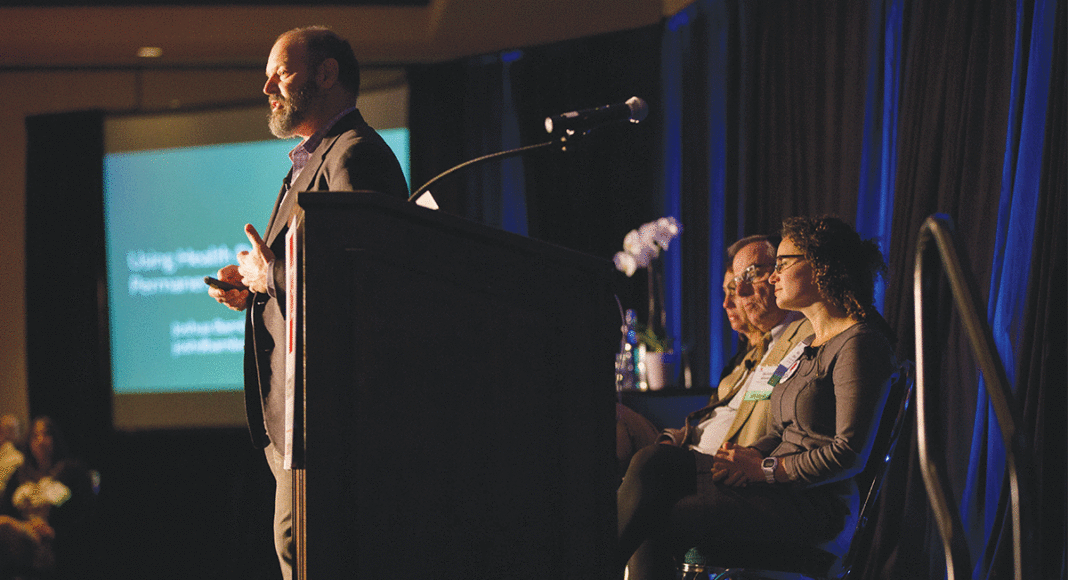Physician Joshua Bamberger does what he can to treat one of his patients, a wheelchair-bound homeless veteran.
But after an appointment draws to a close, Bamberger and the patient go their separate ways, leaving the doctor feeling deeply frustrated on his ride back from work.
“I roll him out to the street corner, I get on BART and go home,” Bamberger tells a crowd of nearly 400 Monterey Bay leaders. “And he’s still there, under the rain and wind, to suffer on the streets, because we haven’t figured a way to serve this one particular individual. That is wrong. That is not what a just society does.”
Housing, he says, is the real solution to this patient’s medical needs. Bamberger was one of more than a dozen speakers at the Monterey Bay Economic Partnership’s “State of the Region” conference at Seaside’s Embassy Suites on Thursday, Dec. 1. Talks centered on housing, health, the environment and transportation, and the area’s affordable housing crisis was a recurring theme.
Stable housing is the primary factor in an individual’s health, yet it’s the least-funded treatment in the healthcare system, says Bamberger, who has spent the past 20 years caring for San Francisco’s homeless.
He urged Monterey Bay entrepreneurs to “get yourself together” and find funding for affordable housing. There are pools of available money out there, he says, such as “community benefit obligations,” which require nonprofit hospitals to give 10 percent of revenue back to the community. Supporting housing qualifies as a benefit, Bamberger says.
Philanthropy is another opportunity, Bamberger says. For example, the Central California Alliance for Health, a nonprofit administering Medi-Cal in Santa Cruz, Monterey and Merced counties, funds grants for mental health, clinic expansion and resources for complex, fragile patients. Of the $116 million set aside for these grants, $10 million is reserved for permanent supportive housing that provides onsite healthcare, says Kathleen McCarthy, the alliance’s business development director and a conference attendee.
A grant for $2.5 million has already been awarded to MidPen Housing, a Foster City nonprofit developer, for a housing complex in Salinas’s Chinatown, McCarthy says.
Bamberger called for the health nonprofit leaders in the audience to invest more in housing.
“We have to ask more of our healthcare system. Stop spending money on expensive tests and medications,” Bamberger says. “We have to stand up and say the healthcare system has to be responsible for the sickest people first and get them into housing first, and then the healthcare costs go down.”
Linda Mandolini, CEO of Eden Housing, a Hayward nonprofit developer, also spoke last Thursday, listing troubling statistics from a recent McKinsey Global Institute report. California ranks 49th out of 50 states in housing units per capita, and needs to build 3.5 million homes by 2025 to satisfy the pent-up demand.
It’s the poorest people who are hit the hardest, but the crisis affects everybody, she says.
“Not building housing doesn’t just affect the people who don’t have anywhere to live. It’s actually a huge economic drag,” says Mandolini, adding that the state loses $140 billion annually from homes not getting built and people spending more on housing than on other consumption.
Nearly 60 percent of households in the Santa Cruz metropolitan area are unable to find housing they can truly afford, meaning that they spend more than 30 percent of their income on housing, she says.
“The solutions to these problems have to start regionally and locally, and if we don’t start regionally and locally, we’re not going to get anywhere,” Mandolini says.
When California dissolved its redevelopment agencies in 2012, much of the local funding for affordable housing disappeared, and companies like hers were severely impacted, she says. With elusive funding, it’s “a huge challenge,” for example, to connect sewer lines under a freeway for a new development, she says.
She says that President-elect Donald Trump’s administration has promised to be “very serious about infrastructure” such as improving water and sewer systems, and urges local leaders to take advantage of the opportunity.
Audience member Julie Conway, Santa Cruz County’s housing manager, says the county used to receive $8 million annually for affordable housing from its redevelopment agency, but now lacks a reliable local source of housing funding, she says.
“The loss of redevelopment was absolutely devastating,” Conway says. “There is nothing on the horizon that comes anywhere close to being the tool that it was.”
A few things give her hope.
She says it’s “encouraging” that San Mateo, Santa Clara and Los Angeles counties passed ballot measures supporting affordable housing this November. She’s unsure whether Santa Cruz County voters would support a similar measure, but is motivated by the success of Measure D, the half-cent sales tax supporting transportation.
The county is also starting to see some revenue from its $15-per-square-foot impact fee on new developments, to fund affordable housing. The county began collecting the fee last year, and it’s still too new to predict how much it will raise, Conway says.
Matt Huerta, Monterey Bay Economic Partnership’s housing program manager, oversees a newly created $10 million revolving loan fund for affordable housing looking for its first project.
He’s trying to build a coalition advocating for affordable housing throughout the region. That’s important because too often when affordable housing proposals come before a planning commission or city council, the loudest voices in the room tend to be the naysayers, he says.
“People are afraid of affordable housing because they buy into the myth that it will create more problems than it solves, whether it’s bringing in ‘those people’ or whether it’s decreasing property values or increasing congestion,” Huerta says. “So I think it’s typically a misunderstanding of how affordable housing really works.”













